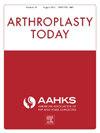机器人辅助全髋关节置换术可降低脱位率
IF 2.1
Q3 ORTHOPEDICS
引用次数: 0
摘要
背景随着机器人技术在全髋关节置换术(THA)中的应用不断普及,与人工技术相比,临床结果的差异仍不明确。本研究旨在比较接受机器人辅助技术和人工全髋关节置换术治疗原发性骨关节炎的患者在 90 天、1 年和 2 年的术后并发症。根据年龄、性别、合并症指数、慢性肾病、肥胖症和糖尿病等因素进行倾向匹配,结果每个队列中有 7652 名患者。我们对术后结果进行了评估,包括手术部位感染、肺栓塞、静脉血栓栓塞、伤口并发症、脱位、无菌翻修、假体周围关节感染和假体周围骨折。我们通过卡方检验完成了双变量分析,以评估分类变量。我们使用学生 t 检验来比较连续变量,包括年龄和合并症。用95%置信区间(CI)计算并发症的比值比(OR)。93 vs 1.41%,OR 0.65,95% CI 0.48-0.88,P = .007)、1 年(1.32 vs 1.92%,OR 0.68,95% CI 0.53-0.88,P = .004)和 2 年(1.66 vs 2.1%,OR 0.79,95% CI 0.62-0.99,P = .049)。机器人辅助组的手术总并发症在1年时明显降低(5.29 vs 6.16%,OR 0.85,95% CI 0.74-0.98,P = .0205),但在90天和2年时相似。90天时,包括手术部位感染、肺栓塞、静脉血栓栓塞和伤口并发症在内的医疗并发症发生率相似(所有P均为0.05)。在所有时间点,假体周围关节感染、无菌性翻修、假体周围骨折和无菌性松动的发生率相似(所有P均为0.05)。这一发现支持在 THA 中使用机器人辅助,但还需要进一步的研究来证实和加强这些发现。本文章由计算机程序翻译,如有差异,请以英文原文为准。
Robotic-Assistance in Total Hip Arthroplasty Is Associated With Decreased Dislocation Rates
Background
As the use of robotics in total hip arthroplasty (THA) continues to gain popularity, differences in clinical outcomes when compared to manual techniques have remained unclear. This study aimed to compare postoperative complications between patients undergoing robotic-assisted techniques and manual THA for primary osteoarthritis at 90 days, 1 year, and 2 years.
Methods
Using an all-payer national database, we identified 405,048 patients who underwent either robotic-assisted or manual THA for primary osteoarthritis. A propensity match was performed for age, sex, a comorbidity index, chronic kidney disease, obesity, and diabetes, resulting in 7652 patients in each cohort. We assessed postoperative outcomes, including surgical site infections, pulmonary emboli, venous thromboemboli, wound complications, dislocations, aseptic revisions, periprosthetic joint infections, and periprosthetic fractures. We completed bivariate analyses via chi-square tests to assess categorical variables. We utilized student’s t-tests to compare continuous variables, including ages and comorbidities. Odds ratios (ORs) were calculated for complications using 95% confidence intervals (CIs).
Results
The robotic-assisted cohort had lower rates of dislocation at 90 days (0.93 vs 1.41%, OR 0.65, 95% CI 0.48-0.88, P = .007), 1 year (1.32 vs 1.92%, OR 0.68, 95% CI 0.53-0.88, P = .004), and 2 years (1.66 vs 2.1%, OR 0.79, 95% CI 0.62-0.99, P = .049). Total surgical complications were significantly lower in the robotic-assisted cohort at 1 year (5.29 vs 6.16%, OR 0.85, 95% CI 0.74-0.98, P = .0205), but were similar at 90 days and 2 years. At 90 days, the rates of medical complications, including surgical site infections, pulmonary emboli, venous thromboemboli, and wound complications, were similar (all P > .05). The rates of periprosthetic joint infections, aseptic revision, periprosthetic fractures, and aseptic loosening were similar at all time points (all P > .05).
Conclusions
Patients who underwent robotic-assisted THA had lower rates of dislocation at 90 days, 1 year, and 2 years. This finding supports the use of robotic assistance in THA, though further research is needed to confirm and strengthen these findings.
求助全文
通过发布文献求助,成功后即可免费获取论文全文。
去求助
来源期刊

Arthroplasty Today
Medicine-Surgery
CiteScore
2.90
自引率
0.00%
发文量
258
审稿时长
40 weeks
期刊介绍:
Arthroplasty Today is a companion journal to the Journal of Arthroplasty. The journal Arthroplasty Today brings together the clinical and scientific foundations for joint replacement of the hip and knee in an open-access, online format. Arthroplasty Today solicits manuscripts of the highest quality from all areas of scientific endeavor that relate to joint replacement or the treatment of its complications, including those dealing with patient outcomes, economic and policy issues, prosthetic design, biomechanics, biomaterials, and biologic response to arthroplasty. The journal focuses on case reports. It is the purpose of Arthroplasty Today to present material to practicing orthopaedic surgeons that will keep them abreast of developments in the field, prove useful in the care of patients, and aid in understanding the scientific foundation of this subspecialty area of joint replacement. The international members of the Editorial Board provide a worldwide perspective for the journal''s area of interest. Their participation ensures that each issue of Arthroplasty Today provides the reader with timely, peer-reviewed articles of the highest quality.
 求助内容:
求助内容: 应助结果提醒方式:
应助结果提醒方式:


